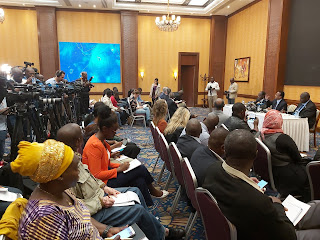FAO declares level 3 emergency over desert locust invasion
 |
| Pic courtesy |
The Food and Agriculture Organisation (FAO) has declared that the ongoing locust invasion is at emergency level 3 situation and this will affect people’s livelihoods and food security and further worsen the food crisis in affected countries.
Speaking at a joint press conference with IGAD Climate Prediction and Applications Centre (ICPAC), Bukar Tijani who is FAO Assistant Director-General,Agriculture and Consumer Protection said that they have put in place a 6 month emergency action plan to avert a foreseeable food, nutrition and pasture crisis for the people and animals affected.
According to FAO, this is the worst situation in 25 years for most countries and the worst situation in 70 years for Kenya.
The East Africa region already faces high levels of food insecurity, with over 19 million people in Crisis (IPC Phase 3) and above.
The risk of spread to South Sudan and Uganda is very high given the currently limited control activities in some countries, and the high mobility and reproductive potential of the Locust.
David Phiri, FAO Subregional Coordinator for Eastern Africa and Representative to the African Union and the United Nations Economic Commission for Africa warned that, “We must act immediately and at scale to combat and contain this invasion. As the rains start in March there will be a new wave of locust breeding. Now is therefore the best time to control the swarms and safeguard."
"Urgent action is required to halt the spread of this devastating infestation and avert a worst-case scenario" said Ms. Gemma Connell, Head of OCHA’s Regional Office for Southern and Eastern Africa. “The Emergency Relief Coordinator, Mr. Mark Lowcock, has released US$10 million from the Central Emergency Response Fund to enable a massive and rapid scale-up in air and ground control operations to reduce locust numbers. However, much more is needed, and we call upon the international community to respond generously at this time of critical need."
FAO has set out key action plans to help avert the locust menace as below;
-Ground surveillance activities for early detection must be increased.
-Radio and other channels should be used to disseminate and educate citizens, including how to report infestations.
-Countries must intensify efforts to control the outbreak. Given the scale of the infestations, the only effective control measure will be upscaled aerial controls (spraying of proper pesticide on swarms). This will require sourcing of additional equipment (planes, ground vehicles, sprayers, pesticide) and personnel in order to upscale the campaign.
Under a worst-case scenario where the Desert Locust upsurge is not quickly contained and becomes a plague by the next main cropping season, significant crop and pasture losses will worsen food security in affected areas.
-It is important to begin implementing measures now to protect people's livelihoods and prevent a future food crisis, including: animal health campaigns, providing feed to keep livestock healthy where forage has been destroyed, as well as providing farming packages so affected households can replant following any losses.


Comments
Post a Comment